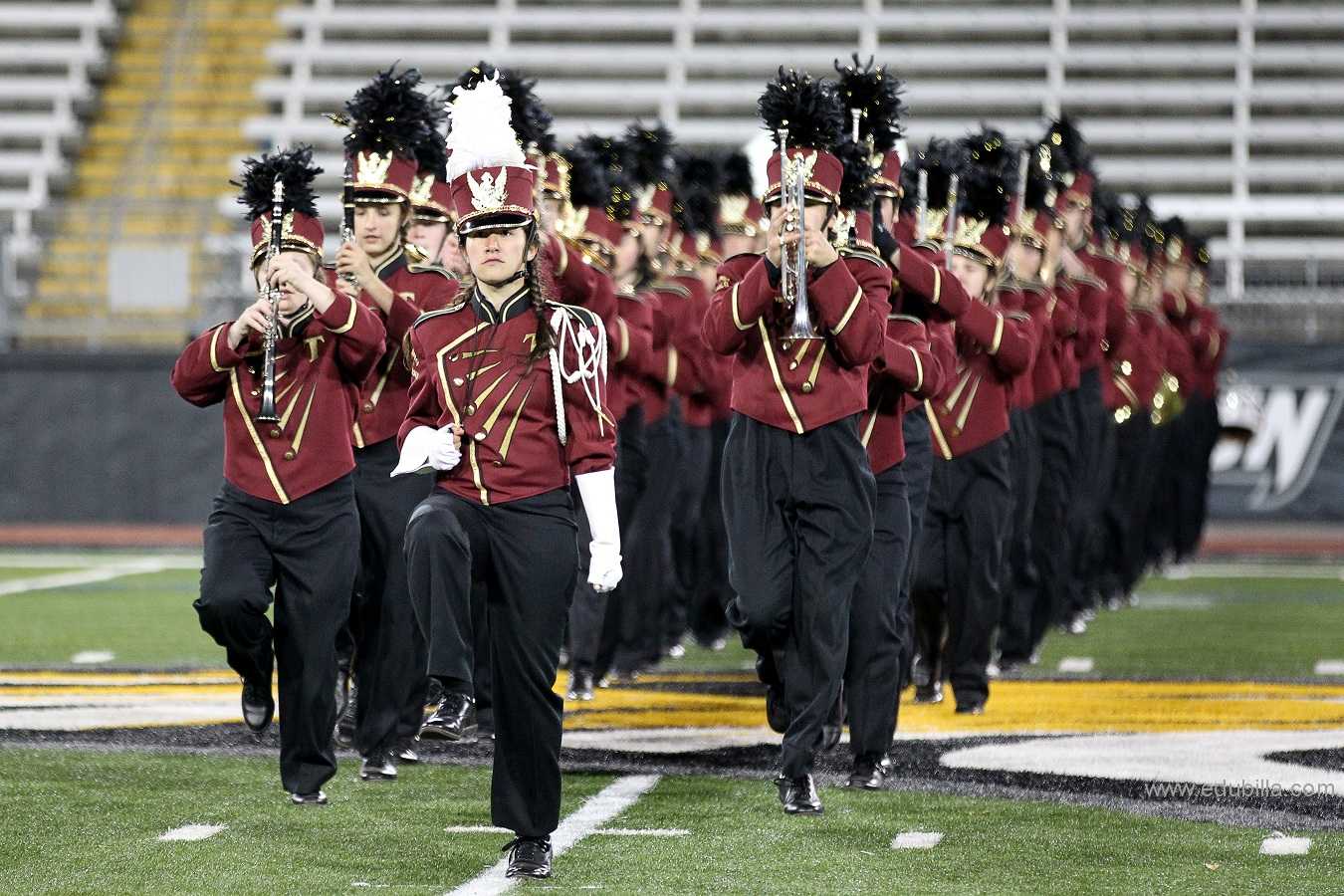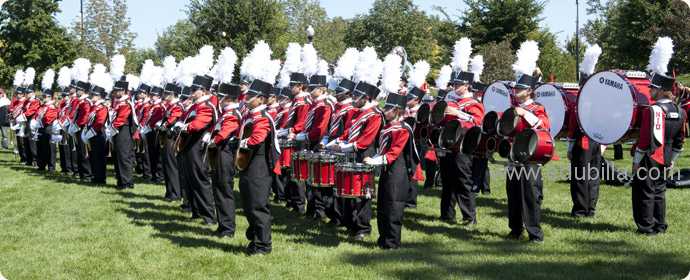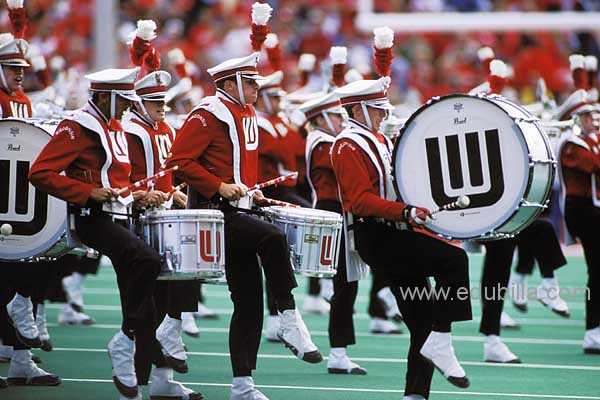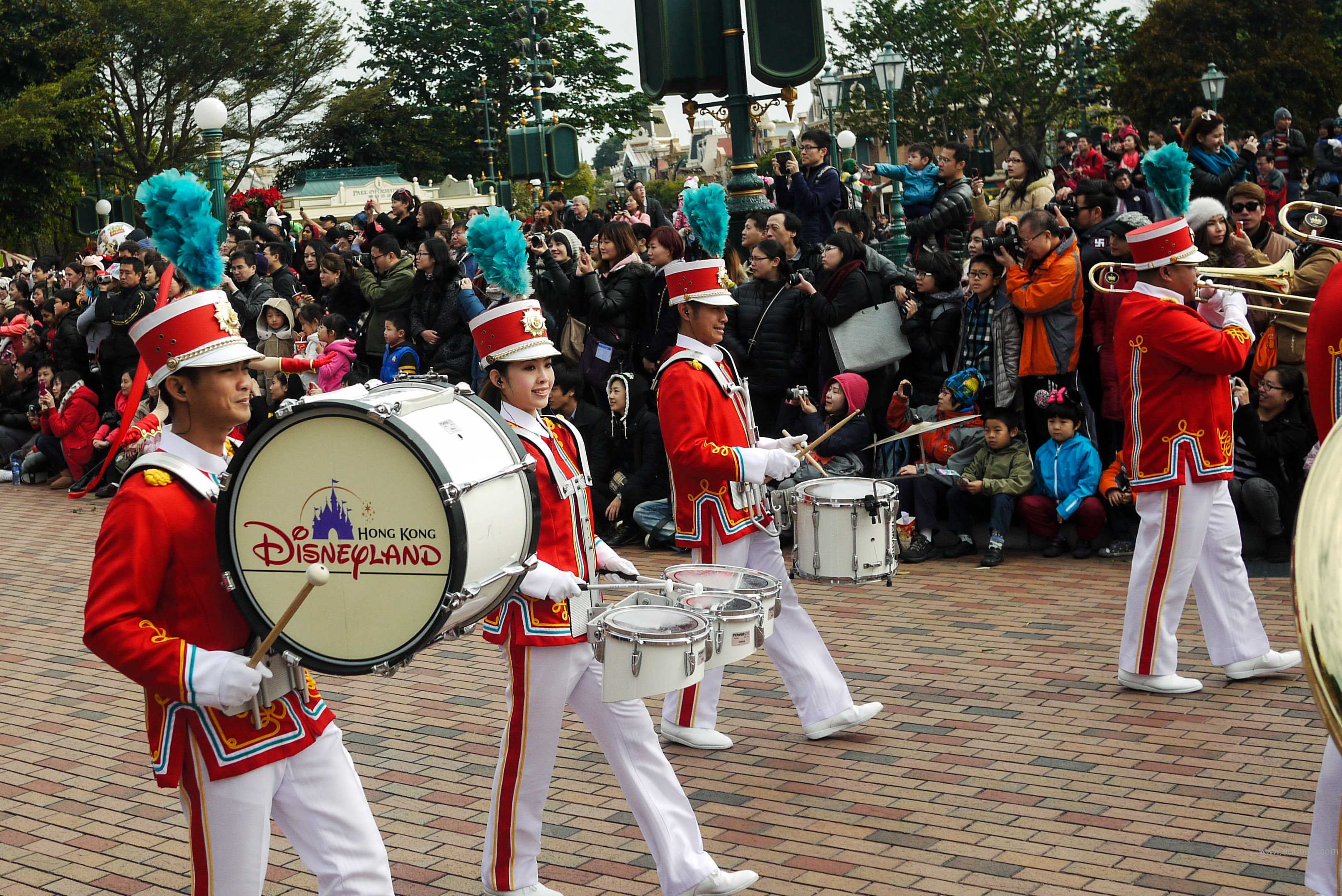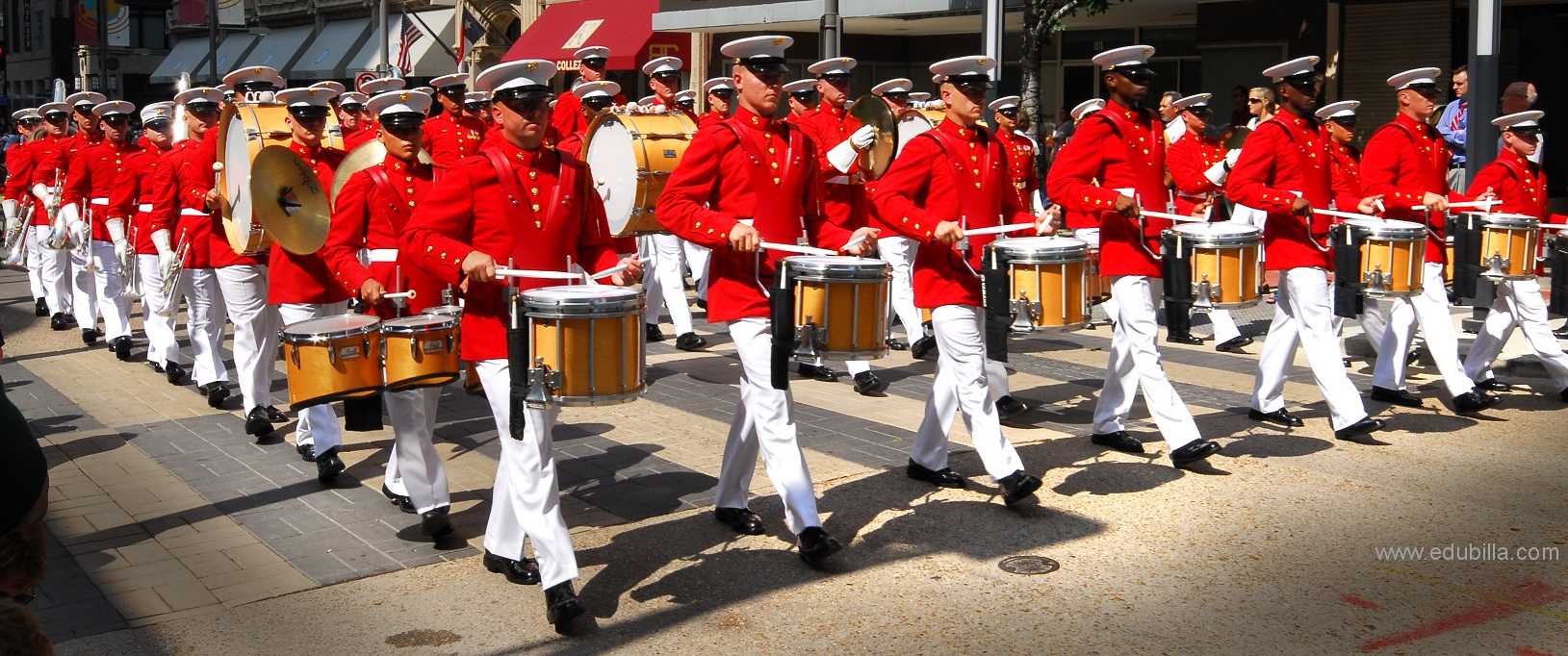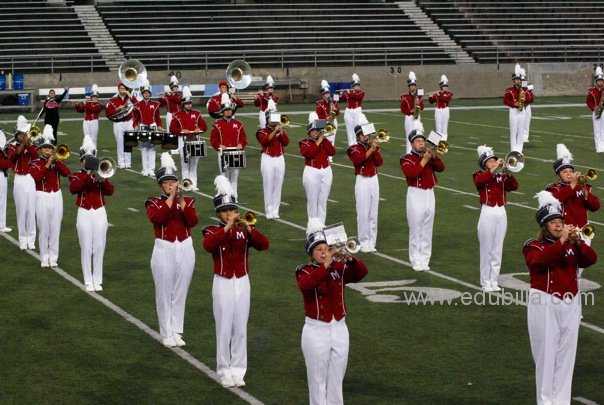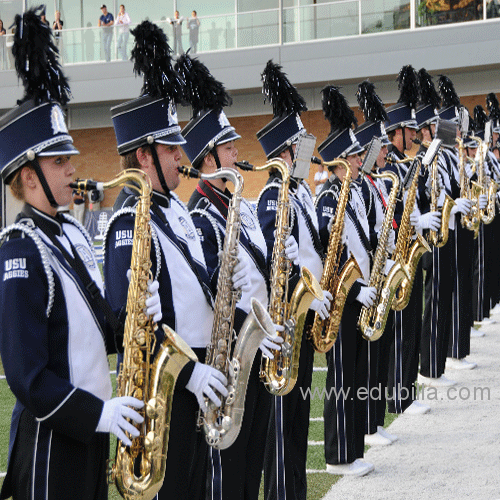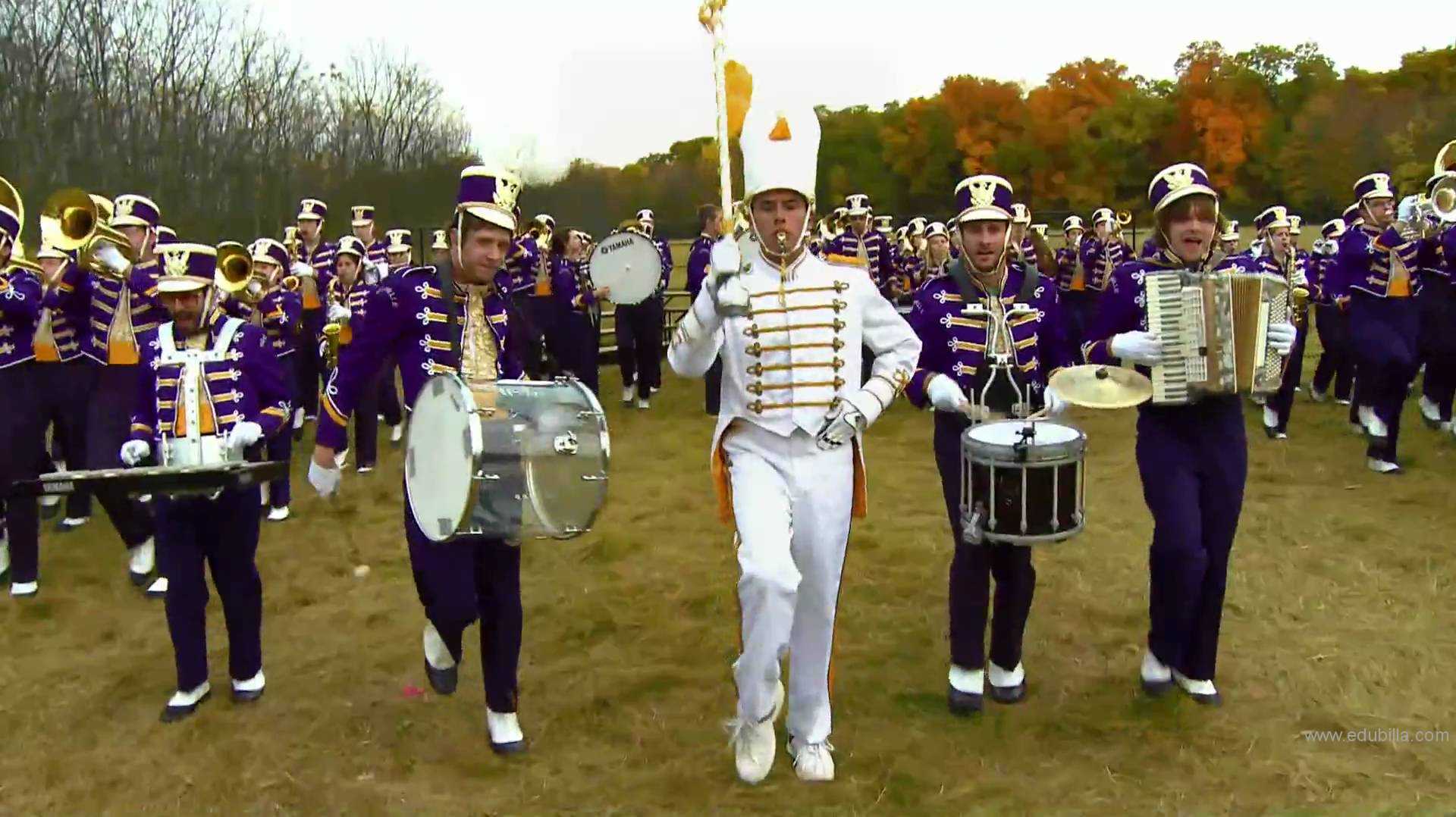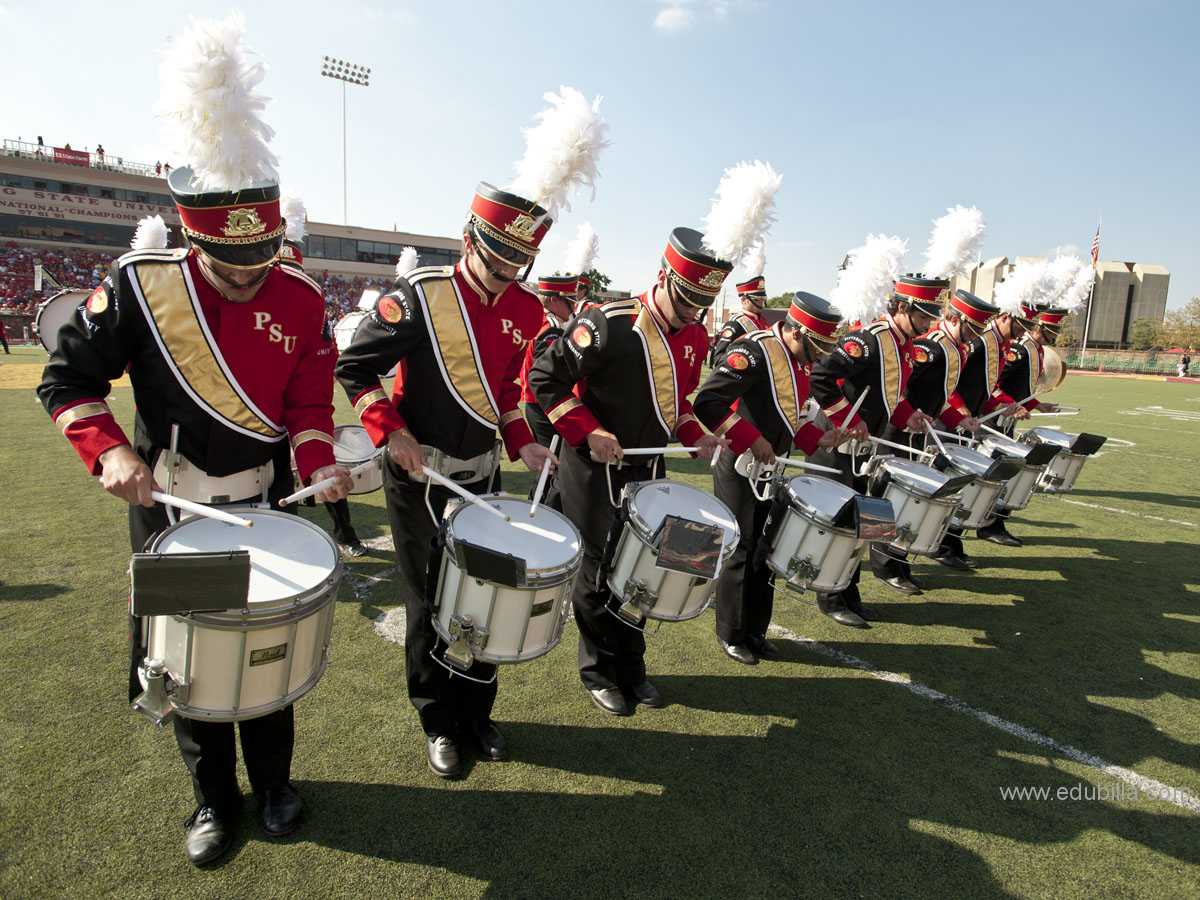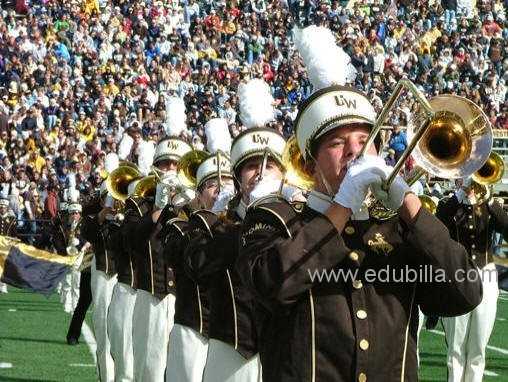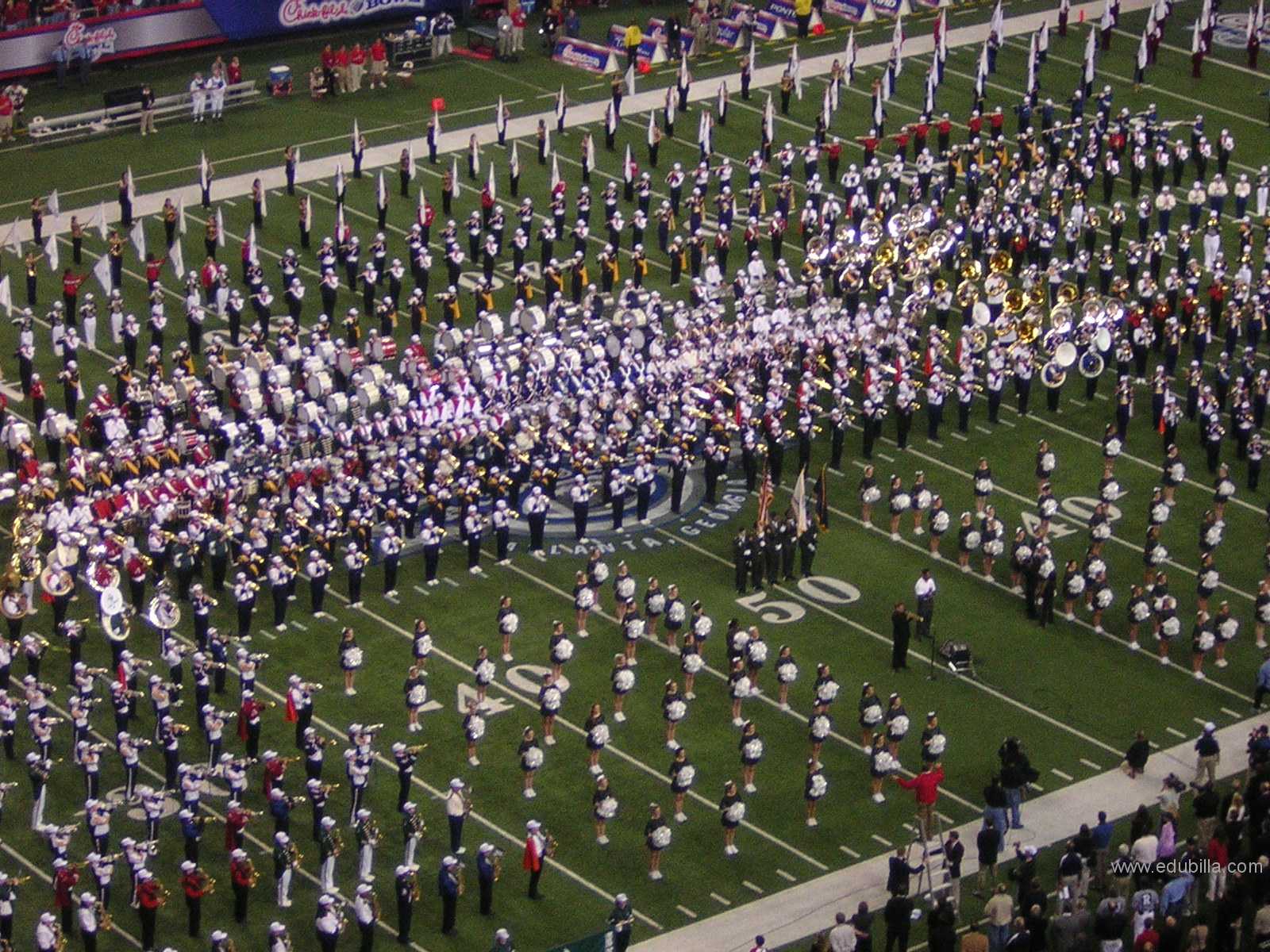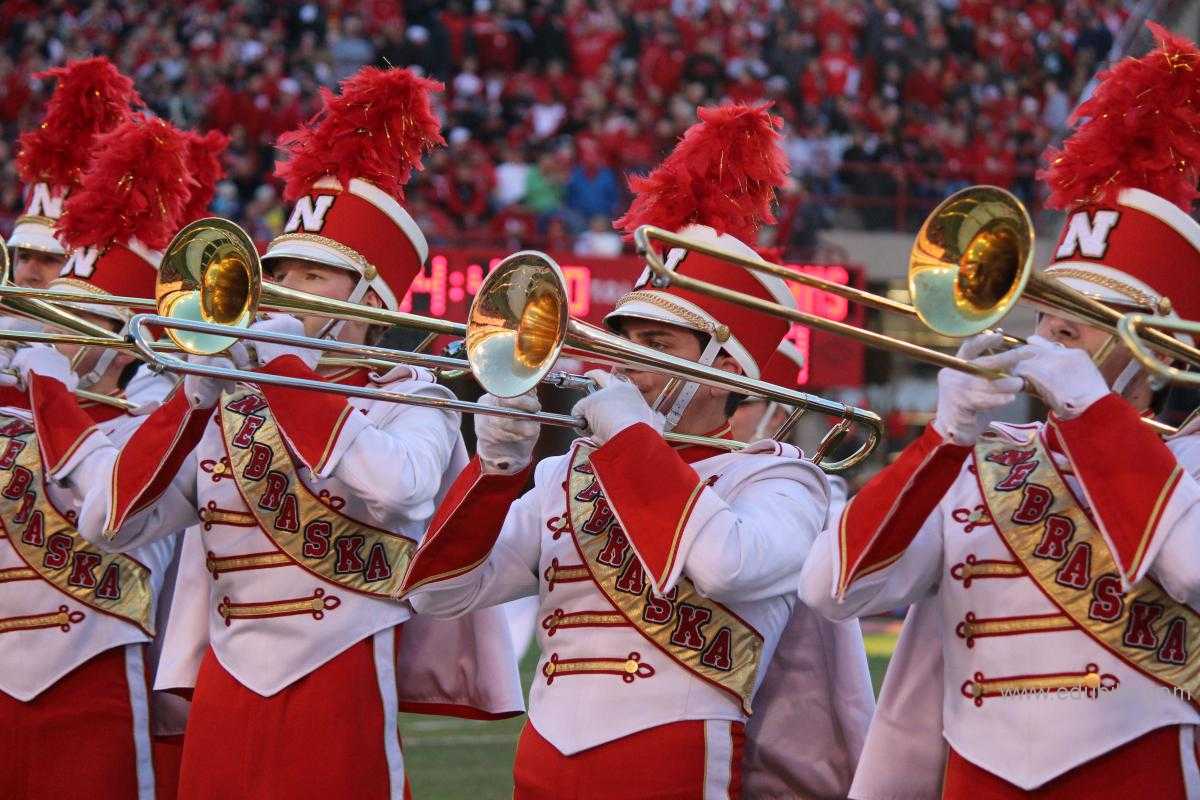
Overview Of Marching Band
Marching band is a sport in which instrumental musicians perform outdoors for the purpose of entertainment, exercise, and sometimes for competition. Instrumentation typically includes brass, woodwinds, and percussion instruments. Most marching bands use some kind of uniform (often of a military style) that include the school or organization's name or symbol, shakos, pith helmets, feather plumes, gloves, and sometimes gauntlets, sashes, and/or capes.
Narching Band Categories:
Marching bands are generally categorized by function, size, age, gender, instruments and by the style of show they perform.
The Main Categories:
Marching bands by nationality(5 C)
College marching bands(4 C, 1 P)
DCI Open Class corps(30 P)
Drum and bugle corps(6 C, 135 P, 7 F)
March music(3 C, 42 P)
Marching band competitions(16 P)
Marching band instruments(1 C, 4 P)
NFL marching bands(2 P)
Pep bands(4 P)
Pipe bands(6 C, 67 P)
Scramble bands(16 P)
Marching band stubs(35 P)
Types of marching bands:
Marching bands can be categorized based on primary function, instrumentation, and style.
Military bands are historically the first of the various marching bands. Instrumentation varies, but generally contain brass, percussion, and woodwinds. Given their original purpose, military marching bands march forward only usually in straight lines; they rarely make curves. Active-duty military marching bands often perform in parades with other military units and march in the same manner as other military personnel. Music is played at a constant tempo in order to provide a steady beat for other military units. Almost all military marching bands have disappeared from schools in the United States. Two notable exceptions are the Fightin' Texas Aggie Band from Texas A&M and the Highty-Tighties of the Virginia Tech Corps of Cadets. In addition, there are about 80 high school military marching bands in East Texas. These bands have formed the National Association of Military Marching Bands in order to preserve the tradition of military marching.
- Parade bands
- Show bands
- HBCU bands
- Drum and bugle corps
- Bugle bands
Game Rules
1. Marching band is not for the faint-hearted, overly religious or the uncorrupted. Don't say I didn't warn you.
2. Let it be known that after a day of marching your instrument shall temporarily gain 20 pounds until the next day, when it shall lose 25.
3.It is a requirement that you shall love Maleguena, or at least be able to tolerate it to a civilized degree in its abundance in the marching society.
4.You shall hate all that is Sousa with the exception of the flute. You guys actually get a half-decent part, you jerks.
5.You must be comfortable with being half naked in public situations. This will be a normal happening in your marching band life.
6. No marching band gathering will ever go without a deck of cards.
7. Be sure to give much gifts and shower praise upon the band director to lessen your chances of being seated by the percussionists. A few sacrifices to the uber band god couldn't hurt, either.
8.It's not a great idea to play "Hide and Go Seek Clarinet" the day before competition.
9.Duct tape fixes everything.
10.Stay 100 feet and back from tuning flutes, and 500 feet in the case of piccolos.
11. It's not you, it's just a fact that no matter what drastic measures you go through, You'll never be at the right temperature in your uniform.
12.A band without strange and odd rituals at the show prep area is hardly a band at all.
13. Let it be known that your efforts in acting and being more perverted and or corrupted than a marching band nerd along with your attempts to gross or creep them out is absolutely futile. Don't even waste your time.
14. Those who are not band members should not engage in prep conversations. Perverted slang for unperverted objects is quite abundant.
15. Do not touch any object placed or lying in a designated marching area; You never know if it is a place marker or not, and tampering of it's position could result in severe injury.
16.Contrary to popular belief, serious marching band isn't just a hobby; It is indeed a way of life. Kinda creepy, eh?
17. No matter the amount of freshman, there is always the whiner, the "know it all", the kiss-up, the competitive one and the all purpose sugar ridden one.
18. Trumpets cannot go for prolonged amount of times without playing random very loud and very high notes. The purpose of this is to boost their egos by outdoing other trumpeters and band members. The only case they refrain from enacting in this impulsive behavior is when they remain in the presence of a Mellophone. They like to keep their egos intact, you know.
19. A marching band will always execute a scheduled visit to the Homestar Runner website on a timely fashion. Why? Nobody knows, but it's like cult humor. Rocky Horror Picture Show, anyone?
20. Common sense should tell you not to hold the bell of your instrument outward during a parade when people are throwing candy at you.
21. It will be a given that marching band geeks are the best people to ask for directions. They actually know the difference between left and right, you know.
22. You have to stroke chickens. Just shut up and do it.
23. It is a fact that as soon as you take 10 minutes to finally get all suited up in your band uniform, you are going to have to use the bathroom.
24. 99.9% of the shows you will see are going to be latin inspired, musicals or movies.
25. There is always going to be a freshman crash, always.
26. You've got to watch out the first time colorguard practices with the marching band if you treasure your life.
27. Don't get too close to the Trombones...you never know what comes out of those guys...
28. It will be the truth that even if you aren't trying, you are still naturally walking in step with the people around you.
29. As soon as you are a marching band nerd, outsiders won't understand you. It really IS a band thing...if you're really into it. Like me, the loser taking the time to write down all these unwritten rules.
30. Sometimes, there really will be a one time at band camp. Infact, there will be a lot of one times at band camp.
31. Thou shalt never, ever touch anothers personal instrument. Doing so will result in a curse of polishing the instrument forever more or the loss of a hand. Seriously.
32. If you have a marching crash, I bet you 10 dollars a Sousaphone was involved.
33. Never ever touch a saxophonist with his saxophone...you wouldn't want people interfering into your time of prayer and worship, would you?
34. 5 out of 4 percussionists have problems with fractions...and everything else.
35. Let it be known that band can never be taken literally. Just because we're all horny and have a few good boners doesn't mean what you think.
36. It will be true that all clarinets will indeed be innocent until they lose the known status upon finding out they really can't ever be heard by the crowd.
37.It will be standard proceedure for a marching band to ritualistically perform useless and purposeless cheers for no other reason than simple minded entertainment.
38. Speaking of the simpleness of marching band geeks...Oooh...shiny...
39. Never fight with a mellophonist...whatever you say, it's going to be wrong. Just take my word on it.
40. It shall always hold constant that the smallest person in your band is always the Sousaphone player. It just always happens that way.
41.No band never can be without an excessively annoying song that is played all the freaking time, giving you extreme pleasure and excitement while bringing you to the point of wanting to rip your eardrums out simultaniously.
Detailed Marching Band Rules Can Be Downloaded From Documents
Equipments Need For Marching Band
Instruments:
Instruments used in the Marching Band can generally be grouped in several categories by type and how to play. Instruments in Marching Band are grouped into 4, namely brass, percussion, pit, flag / Color Gurard. This grouping also indirectly affects the organizational structure of coaching is generally specified by the categories, each category has its own coach. In addition to coaching, this grouping is generally affects the social behavior of the players involved with creating the social classes that make up the non-formal group pride.
1. Brass instruments:
At first, the variety of brass instruments used in marching band identical to that used drum band. But in its development, the variety of brass instruments become more modern. Examples - examples of musical instruments Marching Band furnaces which are used commonly are:
• Trumpets
• Fluglehorn
• Mellophone
• trombone
• Contra Bass / Tuba
• Saxophone
• Flute
2. Percussion Instruments:
Percussion instruments in a marching band is a type mobile instrument carried by the player and played in a row as well as brass instruments. Section who plays percussion instruments while walking is also called the drum line or battery. Variety of percussion instruments used Marching Band is generally less than those used in the past. The instruments are:
• Snare drum
• Quint
• Bass Drum
• Hand Cymbals
3. Musical Instruments Pit (static):
Instruments pit is basically a pitched percussion instrument. In the Marching Band performances, this instrument type is static, the players did not participate in a line like the other instruments but play it in front of the field which is used in appearance. Variety of orchestral instruments used are generally more varied than the sequence drum band. Some of the group Marching Band sometimes even assemble your own pit instruments to produce unique sounds in music that is played. Examples of commonly used instruments in the pit of the Marching Band performances include:
• xylophone
• Vibraphone
• Marimba
• Cymbal Stand
• Chinese Gong
• tympanic
• bass drum concert
• Tubular bell
4. Instruments Flag (Color Guard):
Instruments flag is not used to playing music, but used by players as a tool to produce dance action-effects of certain visual effects that support the appearance. In practice, this instrument players do not always use the flag as an accessory, but can use other tools such as wooden gun (rifle), scarves, pennants, ergantung the choreography to support the overall appearance. But usually the basic instruments used are flags and wooden rifles (rifle).
History Of Marching Band
Marching Band stems from ancient tradition as the activities performed by several musicians who play music together and performed while walking to accompany a celebration or festival. Along with the growth in time, Marching Band evolved into more structured in the military in the early days of the city state era. This forms the basis of the initial military marching band that later became the beginning of the Marching Band at this time. Although the pattern Marching Band has evolved far, there are still quite a lot of military traditions survive in culture Marching Band now. Military tradition is seen in uniform attributes are used, the procedure runs, the model of instruction in the exercise are still largely an adaptation of the military tradition that has been adjusted in such a way.
PDBI (Drum Band All-Indonesia Association):
In Indonesia the culture Marching Band is a further development of the culture drum band that had previously been under the auspices of the organization PDBI (Drum Band All-Indonesia Association) is fostered by Menpora. Marching Band was born as an activity that focuses on the game performances of music and visuals in a balanced way, in contrast with the drum band that focuses more as a sport. During its development, the Marching Band in Indonesia are many variations of techniques to adapt a game that used by groups drum corps in America, especially on percussion instruments. This makes the feature game in the appearance of the Marching Band to be more easily distinguished from the band's drum style appearance.
In 1970:
Since the 1970s, many marching bands have also adopted changes that parallel developments with modern drum and bugle corps tradition. These changes include:
- Marching with a fluid roll step to keep musicians' torsos completely still instead of a traditional high step
- The adaptation of the flag, rifle, and sabre units into "auxiliaries" who march with the band and provide visual flair by spinning and tossing flags or mock weapons
- Moving marching timpani and keyboard-percussion into a stationary sideline percussion section, which has since incorporated many different types of percussion instruments
- The addition of vocalists and/or electric instruments
Fight song:
The field show and marching in formations was the fight song. University fight songs are often closely associated with a university's band. The University of Illinois also had the first fight song, "Illinois Loyalty". Many of the more recognizable and popular fight songs are widely utilized by high schools across the country. Four university fight songs commonly used by high schools are the University of Michigan's "The Victors", The University of Illinois' "Illinois Loyalty", the University of Notre Dame's "Victory March", and the United States Naval Academy's "Anchors Aweigh".
Origin Of Marching Band
Band is a general term for an instrumental group. The marching band originated with traveling musicians who performed together at festivals and celebrations throughout the ancient world. It evolved and became more structured within the armies of the early city-states, becoming the basis for the military band, from which the modern marching band emerged.
Nineteenth Century:
In the late nineteenth century, they became increasingly popular features of American life in part through the musical work and leadership of John Philip Sousa, who headed the U.S.
John Philip Sousa:
John Philip Sousa (November 6, 1854 – March 6, 1932) was an American composer, conductor, band leader, and author of the late nineteenth and early twentieth centuries particularly remembered for his American military marches.Known as "The March King," Sousa held a deep-seated belief that his talent was a God-given gift and that he had a particular responsibility to use that gift in the service of noble ends.
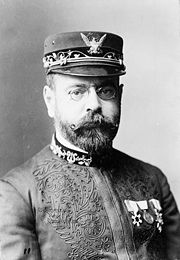
First Halftime Show:
Outside of police and military organizations, the modern marching band is most commonly associated with American football, especially the halftime show. The first halftime show performed by a marching band at a football game was the University of Illinois Marching Illini in 1907, at a game against the University of Chicago.
First Marching band Uniforms:
Founded in 1925, the pep band that would become the UCLA Bruin Marching Band didn't acquire its first uniforms until 1928, and even that required a major push from student body presidential candidate Ken Piper, who also pressed to hire the group's first director, Ben Laietsky.
Those original, military-style costumes with dashing capes arrived just in time to welcome John Philip Sousa on his last visit to Los Angeles.The typical lifespan of a uniform is eight years, Henderson notes, and "UCLA had never gone more than eight years without replacing the entire set, going back to those first uniforms in 1928. They replaced them in 1933, '34, '39, '45 ... They always found the money."
Governing Bodies
World Association of Marching Show Bands(WAMSB):
An international band association dedicated to promoting global communication and interaction between marching show bands.
Aim:
The Association aims to encourage active participation in marching show bands universally, to strenthen the movement internationally and to stimulate the staging of world class band events
WAMSB Objectives:
To enhance the performance and interaction of Marching Show Bands at a world wide level.
•To encourage the development of "World Class Band Events" held in conjunction with "Internationally" recognized events throughout the world.
•To sanction "World Class Events" which will allow Marching Show Bands from anywhere in the world to be performance rated on their individual form and style.
•To establish the required standards for the judgment and performance rating of Marching Show Bands at such sanctioned events.
•To approve standards of operations used at sanctioned events.
•To consult with, and be a resource for such sanctioned events
.•To convene meetings, conventions and other projects to assist in the development of these projects.
To Visit Marching band Click Here.
Awards Related To Marching Band
Sudler Trophy:
The Sudler Trophy is an award bestowed on one university marching band every other year, and was an annual award from 1982 to 2007.
Heisman Trophy:
Heisman Trophy of the collegiate band world",the award does not represent the winner of any championship, but rather a band surrounded by great tradition that has become respected nationally. No school may be honored with the award twice.
Sousa/Ostwald Award:
The Sousa/Ostwald Award is an annual award given by the American Bandmasters Association for a composition for concert band. It was first awarded in 1956, after band uniform suppliers Ernest and Adolph Ostwald established the ABA/Ostwald Award for the best band composition written in the previous year.Previous rules allowed for compositions of grades 1-6, but the rules are undergoing a transition to focus on grades 1-4 (in 2011) and 5-6 (in 2012). The award was renamed from the Ostwald Award in 2011.
The Sudler Flag of Honor:
The Sudler Flag of Honor is an award bestowed to identify, recognize and honor high school band programs internationally that have demonstrated particularly significant high standards of excellence in concert activities over a period of several years. No school may win the award twice under the same director.
The Sudler Flag of Honor is typically considered to be the highest award a high school band can achieve. Sudler Flag laureate bands are automatically included on the Historic Roll of Honor
The Sudler Cup:
The Sudler Cup is an award bestowed to identify, recognize and honor junior high and middle school concert band programs that have demonstrated particularly significant high standards of excellence in concert activities over a period of several years.
Louis Sudler Awards of Merit
Distinguished Service to Music Medal:
The Distinguished Service to Music Medal is an award presented by Kappa Kappa Psi, National Honorary Band Fraternity. It is awarded to people who have contributed to the advancement of the wind band "as a cultural, musical and educational medium."The Distinguished Service to Music Medal has been awarded 137 times to 134 recipients.
Sample Documents Of Marching Band
-Pele

